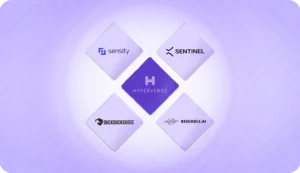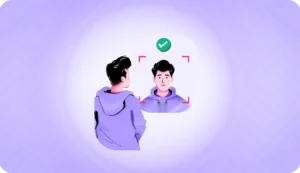We started HyperVerge with the vision of making identity verification more secure, accessible, and affordable for our customers across the globe. Since then, we have come a long way, continuously innovating and pushing the boundaries of what’s possible with AI-powered identity verification.
Our journey has been marked by several key milestones, including being ranked globally among the top on the NIST FRVT 1:1 leaderboard. We have also obtained ISO 30107-1/30107-3 Level 2 compliance certification for our passive liveness technology, making us one of the very few identity verification solutions in the world to achieve this level of compliance.
Today, I am thrilled to announce another significant achievement for HyperVerge. We’ve successfully completed the RIVTD Track 2 (Selfie-ID document match) assessment conducted by the US Department of Homeland Security (DHS).
What does this mean for you?
If you’re evaluating facial recognition software, you might have come across several good players all across the world. These benchmarks by DHS specifically ensure that the solution will provide you with the technology that they claim to—at the highest possible level of accuracy and security.
The fact that HyperVerge is the only system to pass all the DHS benchmarks highlights the exceptional rigor and high standards of this assessment. Out of 16 leading and global systems in the identity verification space, only HyperVerge successfully met the stringent criteria.
Being the only sytem to pass all the DHS benchmarks means that potential users are investing in a technology that has passed rigorous testing against industry standards. It means enhanced reliability in verifying identities with a remarkably low error rate of less than 1%.
Identity fraud is a growing concern, adopting a solution that meets these high benchmarks can provide peace of mind, streamline verification processes, and ultimately protect both the organization and its customers from potential security breaches.
Let me further get into the significance of this assessment for our industry.
Significance of the DHS RIVTD assessment
Identity verification and KYC are not new processes—businesses all over the world need to perform KYC to securely onboard users, open accounts, or issue loans. With so many ways to verify identities—like biometrics, passwords, and ID checks—having some benchmarks to measure how well these methods work is essential.
Here are a few reasons these assessments are important:
- Consistency across different systems: Different companies may use various technologies and methods, making it tough to compare them. Standard benchmarks give us a common ground to see how they really perform.
- Better decision-making: When organizations have access to these benchmarks, they can make smarter choices about which identity verification solutions to use. It helps them weigh the pros and cons of accuracy, speed, and user experience.
- Room for improvement: Regularly checking and updating benchmarks can lead to better technology and processes. This means we can keep enhancing the security and reliability of identity verification systems.
The Remote Identity Validation Tech Demo (RIVTD) is a comprehensive evaluation conducted by the DHS S&T (Science and Technology’s Remote Identity Validation Technology Demonstration) to assess the effectiveness of identity verification technologies.
The objective of this initiative is to identify solutions that can reliably validate identities remotely, especially in contexts where physical verification is not feasible. By evaluating various technologies, the study aims to ensure that identity verification methods are robust, reliable, and can be universally applied across different jurisdictions.
This study is divided into three tracks:
- Track 1 focuses on the accuracy of identity verification methods through various biometric techniques.
- Track 2 evaluates the matching of selfies to official documents, ensuring that the technology can accurately confirm a person’s identity based on their submitted images.
- Track 3 examines the overall user experience and the technology’s ability to function in real-world scenarios.
This benchmark serves as the only global standard for Selfie-ID matching, which is particularly relevant for KYC processes in various countries.
RIVTD track 2 overview
Track 2 focuses on evaluating the effectiveness of remote identity validation technologies in combating identity fraud. This track invites industry participants to showcase their systems’ capabilities in securely and accurately validating identity documents, verifying the document owner’s identity through a selfie image.
The evaluation criteria for Track 2 focus on the ability of systems to accurately match a selfie photo to the image on a government-issued ID document. The main objectives include:
- Image comparison: Assessing the software’s capability to compare images from ID documents and selfies to determine if they depict the same person.
- Imposter detection: Evaluating the system’s effectiveness in detecting attempts at impersonation, particularly when using lost or stolen IDs.
- Performance metrics: Technologies will be measured against realistic and sophisticated attacks to gauge their performance, risks, and fairness in various applications.
- User experience: The systems should be secure, accurate, and user-friendly, facilitating the validation process without compromising security.
The RIVTD Track 2 assessment considers specific thresholds for evaluating the performance of identity validation technologies. According to the provided document, the thresholds include:
- True Positive Rate (TPR): A minimum threshold of 90% is set for the true positive rate, which measures the percentage of correctly identified matches between the selfie and ID document.
- False Positive Rate (FPR): A maximum threshold of 1% is established for the false positive rate, indicating the acceptable level of incorrect matches.
Track 2 results: HyperVerge meets all benchmarks
HyperVerge has emerged as the only system to meet all the stringent benchmarks among the 16 that participated, boasting an impressive error rate of less than 1%. Our technology demonstrated exceptional accuracy and reliability in matching selfies to official documents, reinforcing our position as a leader in the identity verification space.
You can view the official results on DHS’s official website here, where HyperVerge is denoted as MTDS6.
Why is this significant? Accurate face identification can face several challenges:
- Age differences
- Low-quality images from ID cards
- Variations in facial features due to changes in appearance like hairstyle or facial hair
A well-trained face identification model can effectively adapt to these challenges with advanced algorithms that account for variations in age, image quality, and facial features. This adaptability ensures that the system maintains high accuracy, even when presented with less-than-ideal conditions, such as older photographs or images affected by lighting and angle discrepancies.
The model’s ability to recognize and match faces across diverse demographics—regardless of race, age, or gender—further enhances its reliability and robustness in real-world applications. That makes it a crucial tool for identity verification across sectors like banking, gaming, and logistics.
Looking ahead: What does this mean for the future of identity verification?
The results from the DHS S&T RIVTD study signal a promising future for identity verification technologies. As businesses and governments increasingly adopt these standards, the potential for improved security and user experience grows.
Our team has worked tirelessly to develop cutting-edge AI models that can handle diverse facial variations and ID formats, even under challenging conditions. This recognition from the DHS is a testament to our commitment to delivering the best possible identity verification solutions to our customers.
As we look ahead, we remain dedicated to pushing the boundaries of what’s possible with AI and identity verification. We will continue to innovate, collaborate with industry leaders, and work closely with our customers to ensure that HyperVerge remains at the forefront of this rapidly evolving field.
Thank you to our team, partners, and customers for your continued support and trust in HyperVerge. Together, we are making a real difference in the world of identity verification. Learn more about our facial recognition technology or talk to our team of experts.





